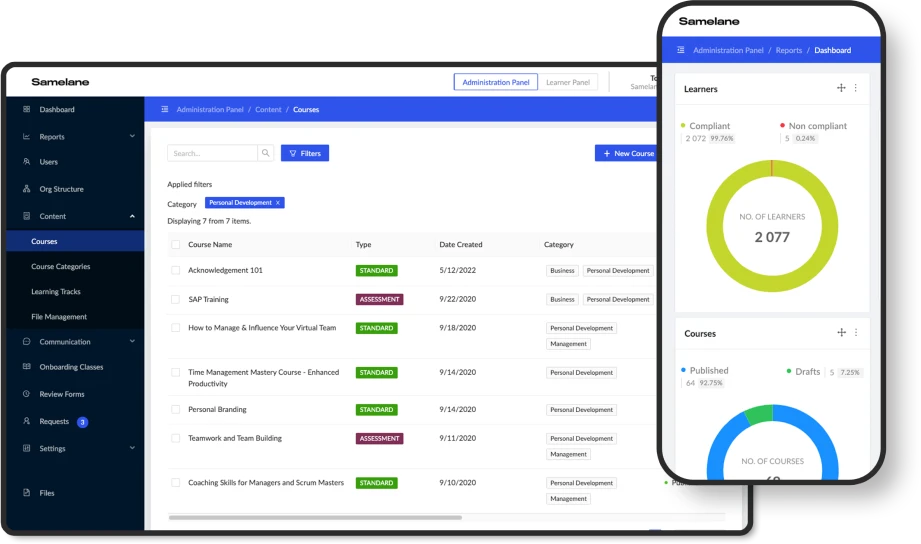Nowadays, learning management systems and e-learning courses are widely used in large companies. They are also more and more often chosen by small and medium-sized entities, which recognize the potential of LMSs, along with the growing and constantly changing training needs. Augmented reality training, which is quickly gaining popularity, effectively engages employees and shortens the time needed to acquire new knowledge and competences. Professional paper writing service can assist in creating educational materials on AR. How does augmented reality work in education?
This article will explain the following:
- What is the difference between augmented reality and virtual reality?
- How is augmented reality (AR) used in training processes?
- What are the main benefits of augmented reality?
What’s the difference between augmented reality and virtual reality?
Augmented reality and virtual reality are often associated with the world of games. This is justified, as just a few years ago these technologies were widely used mainly in games. Today, the situation is completely different. AR and VR were quickly noticed by many other industries, e.g. they are successfully used in science. Augmented reality training was rare until recently, but nowadays it is gaining in importance. Why? AR in education provides unique learning experiences. This translates directly not only into its effectiveness, but also increases student involvement and shortens the time necessary to acquire the discussed material.
Coming back to the subject – how can the two technologies be characterized? Virtual reality (VR) allows the user to move into an illusory, fully digitized environment and to have limited movement opportunities around this imaginary space. This is possible due to the use of special equipment packed with sensors and cameras which are able to reproduce the way and direction of user movement. Augmented reality (AR), in turn, is a technology which also uses specialized equipment, and with its help, supplements the surrounding reality with additional elements. The equipment used by AR (usually glasses or a mobile device) is used to impose additional images or information on the reality around us.
As per recent data, by 2023 there will be an estimated 2.4 billion mobile augmented reality (AR) users worldwide.
Due to the fact that it transfers users to a completely virtual world, VR may be more immersing in the opinion of the user, but from a business perspective, its use is not always economically justified. Creating an illusory world requires considerable costs, mainly but not limited to investing in expensive equipment. Augmented reality provides the user with much more freedom, does not require such advanced equipment, and is therefore more accessible and easier to use in a business environment.
Augmented reality in education
One of the areas which decided to reach for augmented reality relatively quickly is broadly understood education. Schools, professional training companies and business enterprises which, wanting to effectively engage their employees and to remain competitive, decided to take advantage of new technologies, e.g. when designing on-boarding training courses.
Augmented reality can help design a typically boring OHS training in such a way that students have the impression they are participating in an action packed computer game. AR is also perfect for on-the-job training, especially with highly technical features, such as machine operation training. All that is needed is the right tools (glasses or a mobile device) to get to know the structure of a specific machine, find out what role its individual elements play, and how to properly operate it. Augmented reality is also an opportunity for practical skill testing. Learning from one’s own mistakes is generally very effective, and thanks to AR, a trainee can check the knowledge acquired during the course in almost real conditions, but without the risk of damaging the equipment or causing any harm to him- or herself.
5 benefits of augmented reality in education
Augmented reality allows companies to take training courses to a completely new level. How exactly does AR support competency development of employees?
1. It facilitates the acquisition of knowledge and helps overcome cognitive barriers
In many cases, the ability to visualize or imagine the discussed issues or concepts is essential to fully understand them. Unfortunately, not everyone has such abilities, and thus the level of topic understanding is often unsatisfactory. In many cases, augmented reality can effectively replace human imagination and place objects or devices in front of the learner’s eyes at the right moment in the training (e.g. a product or new equipment).

2. It helps remember the acquired knowledge for longer
The use of AR means, on the one hand, higher effectiveness, and on the other, a chance to stimulate the curiosity of students, secure their greater involvement, and provide the possibility to test the acquired knowledge in an extremely interactive way and in conditions similar to real ones. All this translates into more effective acquisition of knowledge and remembering the material for longer periods of time. It is much easier to recall specific situations or images rather than mere facts or definitions.
3. It saves time and money
Augmented reality also translates into economic profits. This is perfectly illustrated in the example of technical job training. As a rule, an experienced employee is delegated to conduct such a training course, where he or she explains, step by step, machine operation, possible problems and proper solutions. Meanwhile, augmented reality can effectively substitute for an experienced instructor – it provides the trainee with all the necessary information and exercises on a virtual model.
4. It guarantees a safe learning environment
AR offers employees a wide range of cognitive possibilities while ensuring a safe working environment. The employee can thus take risks and make decisions based on the knowledge possessed at a particular moment, and also test it. This positively affects the effectiveness of the training process and, at the same time, does not expose the company to any material or image losses.
5. It has an unusually wide range of uses
The possibilities to use AR in the employee training process are almost limitless. It is perfect for position or on-boarding training courses and other types of education.
The best LMS using augmented reality
Today, there are some learning management systems on the market which provide augmented reality, but not all of them are adequately effective or intuitive. When choosing an LMS for your company, it is worth starting with a thorough analysis of needs and a careful assessment of the solutions available on the market.
Samelane is a learning management system featuring both artificial intelligence and AR. It effectively takes training to a completely new level by making it highly interactive and enriching it with virtual models of machines, devices, buildings, or other elements – all from the level of an intuitive interface and drag-and-drop technology. Book a demo today and learn about Samelane’s possibilities and its AR feature.










